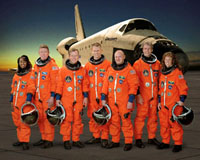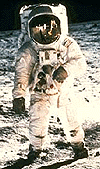 |
|
| Science
& Technology >
Space |
|
The Space Age has run almost in tandem with the Atomic Age. In 1957, the Soviet Union launched the first satellite, Sputnik I, and the United States followed with Explorer I in 1958. The first manned space flights were made in the spring of 1961, first by Soviet cosmonaut Yuri Gagarin and then by American astronaut, Alan B. Shepard, Jr. In 1961, President Kennedy promised that Americans would walk on the moon before the decade was over and in July of 1969, Neil Armstrong stepped onto the moon's surface. On April 12, 1981, the Space Shuttle orbiter Columbia lifted off from its pad at the Kennedy Space Center, six years after the last American astronaut returned from space following the cooperative U.S./USSR Apollo-Soyuz Test Project. Since 1981, there have been nearly one hundred Shuttle missions into Earth orbit, where a variety of scientific and practical activities have been accomplished. President Ronald Reagan in 1984 committed the U.S. to developing a permanently occupied space station and with NASA invited other countries to join in the project. In 1991, President George Bush and Soviet Premier Mikhail Gorbachev agreed to joint Space Shuttle-Mir missions that later would lay the groundwork for cooperative space station efforts. President Bill Clinton in 1993 directed NASA to cut the program's cost and complexity while jump-starting the Station's research capabilities and bringing Russia into the fold. NASA carried out the President's directive, and in addition to the Russian hardware already built or under construction for the International Space Station, that nation's contributions to the program included the nine joint Shuttle-Mir missions conducted from 1994 through 1998. The redesigned orbiting research
center was named the "International
Space Station." It provides more research opportunities, can carry
more crew, requires less maintenance, generates higher power, and can
handle contingencies more effectively than any spacecraft before it.
Sixteen countries -- including 11 members of the European Space Agency
-- today are members of the International Space Station Team. In January 2004 President Bush announced a new vision for the Nation's space exploration program. The President committed the United States to a long-term human and robotic program to explore the solar system, starting with a return to the Moon that will ultimately enable future exploration of Mars and other destinations.
From the first tentative steps of the 1969 moon landing to today's reusable space shuttle, the space program has produced a range of secondary uses of aerospace technology. Communications satellites transmit computer data, telephone calls, and radio and television broadcasts. Weather satellites furnish the data necessary to provide early warnings of severe storms. Space technology has generated thousands of products and services ranging from the lightweight materials used in running shoes to respiratory monitors. |
|||
| Texts
are abridged from U.S. State Department IIP
publications and other U.S. government materials. |
|||
| What
kind of information materials are available?
CD: These documents are available in fulltext format on the About the USA CD-ROM. Teachers: Request a copy for classroom use. L: Selected documents are available in German as well as other languages, including Arabic, Chinese, French, Spanish, Persian and Turkish. |
DISCLAIMER
Any reference obtained from this server to a specific commercial product, process, or service does not constitute or imply an endorsement by the United States Government of the product, process, or service, or its producer or provider. The views and opinions expressed in any referenced document do not necessarily state or reflect those of the United States Government. |


